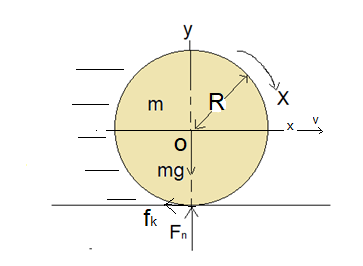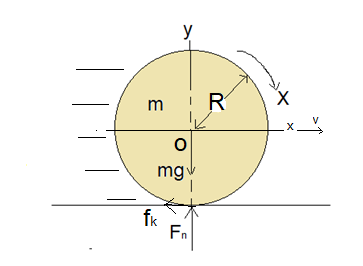
Concept explainers
(a)
The speed of the ball as it begins rolling without slipping.
(a)
Answer to Problem 107P
Explanation of Solution
Given:
Radius of the ball is
Initial speed of the ball is
The coefficient of kinetic friction between the ball and billiard table is
Forward spin of the ball just after its release is
Formula Used:

FIGURE: 1
Constant acceleration equation that relates the speed of the ball to the acceleration and time,
Where,
Referring to the force diagram shown in figure 1, applying Newton’s second law to the ball when it is rolling without slipping,
And
Where,
Calculation:
Where,
From equation
Substituting this in equation
Now,substituting the expression for
Substituting for
From equation
Moment of inertia with respect to an axis through the center of the ball is
Substituting for
Now let us write constant-acceleration equation that connects angular speed of the ball to the angular acceleration and time,
Imposing the condition for rolling the ball without slipping,
Substituting for
Now equate the equations
Substituting this
Conclusion:
The speed of the ball as it begins rolling without slipping is
(b)
The time the ball moves before it begins to rolling without slipping .
(b)
Answer to Problem 107P
Explanation of Solution
Given:
Radius of the ball is
Initial speed of the ball is
The coefficient of kinetic friction between the ball and billiard table is
Forward spin of the ball just after its release is
Formula Used:

FIGURE: 2
Constant acceleration equation that relates the speed of the ball to the acceleration and time,
Where,
Referring to the force diagram shown in figure 2, applying Newton’s second law to the ball when it is rolling without slipping,
And
Where,
Calculation:
Where,
From equation
Substituting this in equation
Now,substituting the expression for
Substituting for
From equation
Moment of inertia with respect to an axis through the center of the ball is
Substituting for
Now let us write constant-acceleration equation that connects angular speed of the ball to the angular acceleration and time,
Imposing the condition for rolling the ball without slipping,
Substituting for
Now equate the equations
Conclusion:
The time the ball moves before it begins to rolling without slipping
(c)
The distance slide down the lane by the ball before it begins rolling without slipping.
(c)
Answer to Problem 107P
Explanation of Solution
Given:
Radius of the ball is
Initial speed of the ball is
The coefficient of kinetic friction between the ball and billiard table is
Forward spin of the ball just after its release is
Calculation:
Let
Now let us write expression that relates
Average speed of the ball is,
Substituting this average speed in equation
Substituting for
Conclusion:
The distance slide down the lane by the ball before it begins rolling without slipping is
Want to see more full solutions like this?
Chapter 9 Solutions
PHYSICS F/SCI.+ENGRS.,STAND.-W/ACCESS
- A long, straight wire carries a current of 10 A along what we’ll define to the be x-axis. A square loopin the x-y plane with side length 0.1 m is placed near the wire such that its closest side is parallel tothe wire and 0.05 m away.• Calculate the magnetic flux through the loop using Ampere’s law.arrow_forwardDescribe the motion of a charged particle entering a uniform magnetic field at an angle to the fieldlines. Include a diagram showing the velocity vector, magnetic field lines, and the path of the particle.arrow_forwardDiscuss the differences between the Biot-Savart law and Coulomb’s law in terms of their applicationsand the physical quantities they describe.arrow_forward
- Explain why Ampere’s law can be used to find the magnetic field inside a solenoid but not outside.arrow_forward3. An Atwood machine consists of two masses, mA and m B, which are connected by an inelastic cord of negligible mass that passes over a pulley. If the pulley has radius RO and moment of inertia I about its axle, determine the acceleration of the masses mA and m B, and compare to the situation where the moment of inertia of the pulley is ignored. Ignore friction at the axle O. Use angular momentum and torque in this solutionarrow_forwardA 0.850-m-long metal bar is pulled to the right at a steady 5.0 m/s perpendicular to a uniform, 0.650-T magnetic field. The bar rides on parallel metal rails connected through a 25-Ω, resistor (Figure 1), so the apparatus makes a complete circuit. Ignore the resistance of the bar and the rails. Please explain how to find the direction of the induced current.arrow_forward
- For each of the actions depicted, determine the direction (right, left, or zero) of the current induced to flow through the resistor in the circuit containing the secondary coil. The coils are wrapped around a plastic core. Immediately after the switch is closed, as shown in the figure, (Figure 1) in which direction does the current flow through the resistor? If the switch is then opened, as shown in the figure, in which direction does the current flow through the resistor? I have the answers to the question, but would like to understand the logic behind the answers. Please show steps.arrow_forwardWhen violet light of wavelength 415 nm falls on a single slit, it creates a central diffraction peak that is 8.60 cm wide on a screen that is 2.80 m away. Part A How wide is the slit? ΟΙ ΑΣΦ ? D= 2.7.10-8 Submit Previous Answers Request Answer × Incorrect; Try Again; 8 attempts remaining marrow_forwardTwo complex values are z1=8 + 8i, z2=15 + 7 i. z1∗ and z2∗ are the complex conjugate values. Any complex value can be expessed in the form of a+bi=reiθ. Find θ for (z1-z∗2)/z1+z2∗. Find r and θ for (z1−z2∗)z1z2∗ Please show all stepsarrow_forward
- Calculate the center of mass of the hollow cone shown below. Clearly specify the origin and the coordinate system you are using. Z r Y h Xarrow_forward12. If all three collisions in the figure below are totally inelastic, which will cause more damage? (think about which collision has a larger amount of kinetic energy dissipated/lost to the environment? I m II III A. I B. II C. III m m v brick wall ע ע 0.5v 2v 0.5m D. I and II E. II and III F. I and III G. I, II and III (all of them) 2marrow_forwardCan you solve this 2 question teach me step by step and draw for mearrow_forward
 Principles of Physics: A Calculus-Based TextPhysicsISBN:9781133104261Author:Raymond A. Serway, John W. JewettPublisher:Cengage Learning
Principles of Physics: A Calculus-Based TextPhysicsISBN:9781133104261Author:Raymond A. Serway, John W. JewettPublisher:Cengage Learning Physics for Scientists and Engineers: Foundations...PhysicsISBN:9781133939146Author:Katz, Debora M.Publisher:Cengage Learning
Physics for Scientists and Engineers: Foundations...PhysicsISBN:9781133939146Author:Katz, Debora M.Publisher:Cengage Learning University Physics Volume 1PhysicsISBN:9781938168277Author:William Moebs, Samuel J. Ling, Jeff SannyPublisher:OpenStax - Rice University
University Physics Volume 1PhysicsISBN:9781938168277Author:William Moebs, Samuel J. Ling, Jeff SannyPublisher:OpenStax - Rice University Classical Dynamics of Particles and SystemsPhysicsISBN:9780534408961Author:Stephen T. Thornton, Jerry B. MarionPublisher:Cengage Learning
Classical Dynamics of Particles and SystemsPhysicsISBN:9780534408961Author:Stephen T. Thornton, Jerry B. MarionPublisher:Cengage Learning Glencoe Physics: Principles and Problems, Student...PhysicsISBN:9780078807213Author:Paul W. ZitzewitzPublisher:Glencoe/McGraw-Hill
Glencoe Physics: Principles and Problems, Student...PhysicsISBN:9780078807213Author:Paul W. ZitzewitzPublisher:Glencoe/McGraw-Hill College PhysicsPhysicsISBN:9781305952300Author:Raymond A. Serway, Chris VuillePublisher:Cengage Learning
College PhysicsPhysicsISBN:9781305952300Author:Raymond A. Serway, Chris VuillePublisher:Cengage Learning





